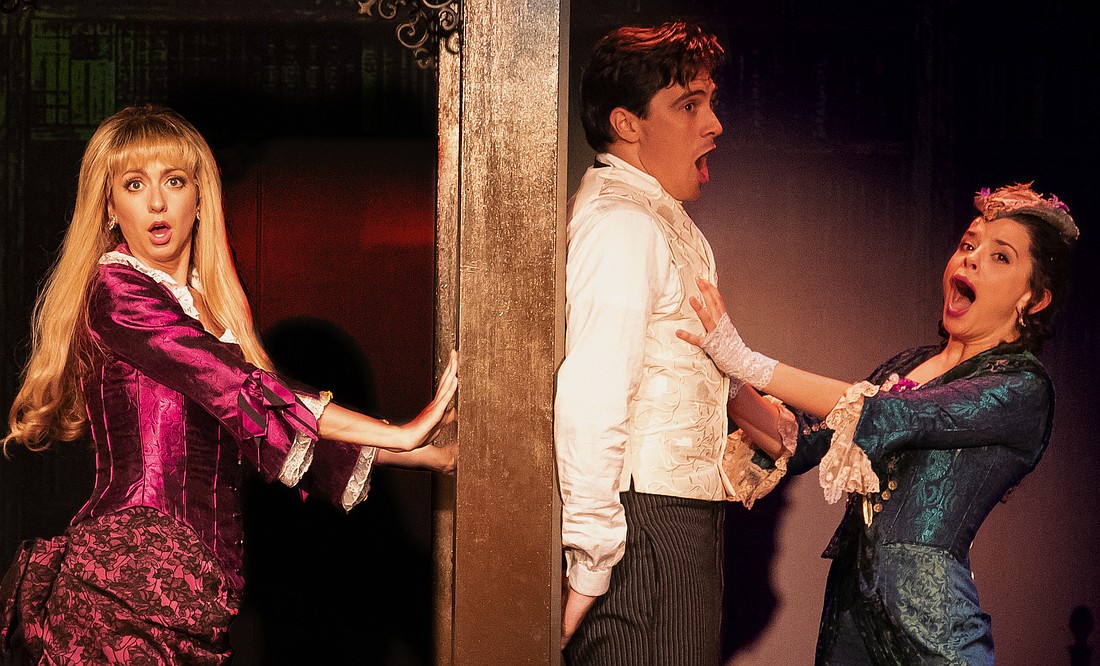- May 12, 2025
-
-
Loading

Murder is nothing to sing about. Well, theoretically. But Broadway does it all the time, the Tony Award-winning “A Gentleman’s Guide to Love and Murder” being a case in point. Robert L. Freedman wrote the script and lyrics; and Steven Lutvak composed the score. The musical’s now racking up the body count at Florida Studio Theatre.
The year is 1907. Monty Navarro is a struggling, young British clerk, following in the footsteps of Bob Cratchit. Knock-knock. A mysterious visitor enters. She has good news and bad. Good news: Monty is a D’Ysquith, and in the line of succession to be the next Earl of Highhurst. Bad news: There are eight people ahead of him in line. For Monty to gain the earldom, they all must kick the bucket. He quickly starts a bucket list. And Monty’s murderous motive is more than money. His Mother was a D’Ysquith. The family disinherited her, when she eloped with a Castilian guitar player — Monty’s father, naturally. After dad died in Monty’s infancy, the family coldly denied his mother’s appeals for help. Mom then worked herself to an early grave. Monty now works hard to install the remaining D’Ysquiths in their graves.
Monty (Jimmy Nicholas) is as creative as Wile E. Coyote when it comes to the art of murder. He riles up bees, saws holes in frozen ponds, and sends human snacks to cannibals — and that’s only a sample. You don’t sympathize with the victims — they’re perfectly obnoxious, and Monty is a perfect gentleman. His victims also have a strong family resemblance. (They’re played by the same actor, Richard Henry, who naturally looks like himself despite costume changes.)
While dispatching D’Ysquiths, Monty rises in social station, and winds up as the apex of an uneasy love triangle. The base is comprised by Sibella (Sarah Ellis), a social climber who ditched Monty when he was poor; and Phoebe (Alexandra Zorn), the goodhearted sister of one of Monty’s victims.
Director Jason Cannon takes the audience on a wild ride. The musical’s a mutant hybrid of “Sweeney Todd” and “Pirates of Penzance.” It’s exactly what you’d expect. (And never what you’d expect.)
The musical’s machinery depends on great comic actors. (Ten actors, playing 86 characters.) Those roles are played for laughs, but they’re demanding. The musical’s tone is over-the-top, but stops just short of camp. The characters are caricatures, broad, but not two-dimensional. They actors have to walk a tightrope in every scene, often while dancing and singing. I’m happy to say, they never fall off.
Henry is a deft shapeshifter. He morphs into eight different D’Ysquiths of assorted ages and genders with subtle shifts of dialect and body language. (You can tell it’s him, but that’s the joke.) Sibella and Phoebe form the yin and yang of feminine attraction. (Or Betty and Veronica.) Ellis’ Sibella is pouty, needy, self-centered, and sexually manipulative. Despite her lofty pedigree, Zorn’s Phoebe is a good egg. Moral, upright, sincere, unstudied. For reasons unknown, they both love Monty. The background characters also get some love. The supporting cast gets a workout portraying assorted bearers, butlers, flunkies, conspirators, cops, and fall guys. They never phone it in.
The musical’s plot is a baroque machine of plots within plots. Isabel and Moriah Curley-Clay’s set design echoes this nested clockwork — a concentric series of frames, one inside the other. The panels closest to the stage display a painting of the D’Ysquith family tree, with a portrait on each branch. (Monty gleefully X’s out each victim as he chops the tree down.) The projection screens at the back supply surreal, imagery to fit the action.
The musical’s style reminds me of Gilbert and Sullivan’s patter songs, with their cynical jibes and fast-paced lyrics. Some tunes deliver important plot points. Others are just plain funny. “I Don’t Understand the Poor” is my favorite. The lament of an aristocrat who thinks poverty is a bad style choice.
Kudos to music director Darren Server and his hidden band for bringing the tunes to life. (Or death, as the case may be.) Choreographer Savannah Holds keeps the cast happily dancing to their final reward. The costumes (derived from Linda Cho’s original designs on Broadway) have a paper-doll, dress-up feel that perfectly suits the musical’s parade of caricatures.
It’s an entertaining, fast-paced show, packed with sneeringly sarcastic songs and a grab bag of cartoonish killings. If you take the material seriously for a second, you’d stop laughing. The musical never does — and never mixes mortality with morality. Its only implied moral lesson is a well-aimed brick through the stained glass windows of the stuffy British class system. That brick would’ve been old in 1907.
The musical unfolds in a frame story where the young man’s writing his prison memoirs while awaiting a verdict — ironically, for a murder he didn’t commit. But Monty’s no slouch in that department. He sent seven D’Ysquiths to their graves. He surely deserves to pay …
So, does Monty get away with murder?
In the original novel (and “Kind Hearts and Coronets,” its Ealing Studios film adaptation) justice is served. In this musical adaptation, justice is slippery. To say more would be ungentlemanly.